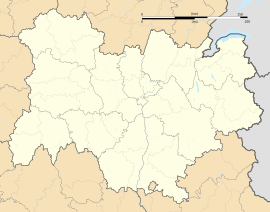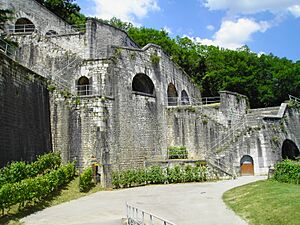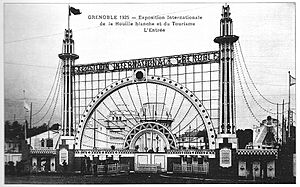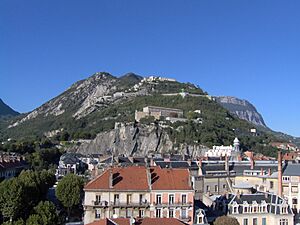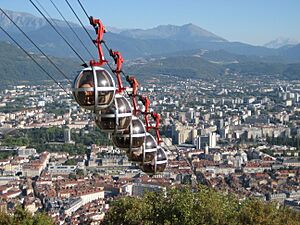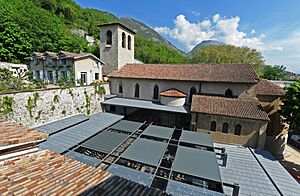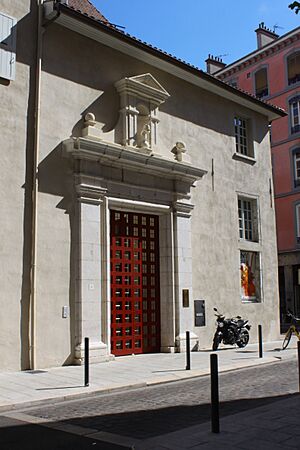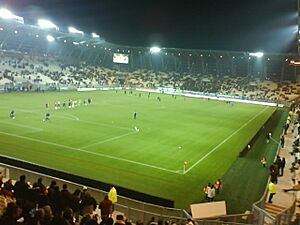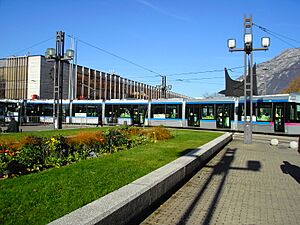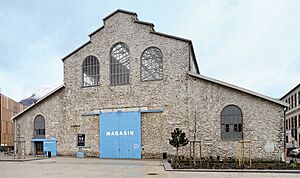Grenoble facts for kids
Quick facts for kids
Grenoble
|
|||
|---|---|---|---|
|
Prefecture and commune
|
|||

From upper left: Panorama of the city, Grenoble’s cable cars, place Saint-André, jardin de ville, banks of the Isère
|
|||
|
|||
| Country | France | ||
| Region | Auvergne-Rhône-Alpes | ||
| Department | Isère | ||
| Arrondissement | Grenoble | ||
| Canton | Grenoble-1, 2, 3 and 4 | ||
| Intercommunality | Grenoble-Alpes Métropole | ||
| Area
1
|
18.13 km2 (7.00 sq mi) | ||
| • Urban | 358.1 km2 (138.3 sq mi) | ||
| • Metro | 2,876 km2 (1,110 sq mi) | ||
| Population
(2021)
|
157,477 | ||
| • Density | 8,686.0/km2 (22,497/sq mi) | ||
| • Urban
(2018)
|
451,096 | ||
| • Urban density | 1,259.69/km2 (3,262.6/sq mi) | ||
| • Metro
(2018)
|
714,799 | ||
| • Metro density | 248.54/km2 (643.71/sq mi) | ||
| Time zone | UTC+01:00 (CET) | ||
| • Summer (DST) | UTC+02:00 (CEST) | ||
| INSEE/Postal code |
38185 /38000, 38100
|
||
| Elevation | 212–500 m (696–1,640 ft) (avg. 398 m or 1,306 ft) |
||
| 1 French Land Register data, which excludes lakes, ponds, glaciers > 1 km2 (0.386 sq mi or 247 acres) and river estuaries. | |||
Grenoble is a major city in southeastern France. It is the main city of the Isère area. It sits where the Drac and Isère rivers meet, right at the foot of the French Alps.
Grenoble is known as the "Capital of the Alps." This is because it's the biggest city in the Alps region. About 158,198 people lived in Grenoble in 2019. The larger Grenoble area has over 714,799 people.
The city has a long history, going back more than 2,000 years. It was once the capital of a French province called Dauphiné. Over time, Grenoble became a very important place for science and technology in Europe. In 2022, it was even named the European Green Capital.
Contents
History of Grenoble
Grenoble has a rich past, from ancient times to modern days.
Ancient Beginnings
The first records of Grenoble are from 43 BC. Back then, it was a small village called Cularo. It belonged to a Gallic tribe called the Allobroges. A bridge crossed the Isère river here.
Around 286 AD, a strong wall was built around the town. This was to protect it as the Roman Empire became less secure. In 381 AD, the Roman Emperor Gratian visited Cularo. He liked the people so much that he made it a Roman city. He renamed it Gratianopolis, which later became Grenoble.
Christianity arrived in the 4th century. The first bishop of Grenoble was chosen in 377 AD. Bishops had a lot of power in the city until the French Revolution.
The Middle Ages
After the Roman Empire fell, Grenoble became part of the Kingdom of Burgundy. In 1032, it joined the Holy Roman Empire.
In the 11th century, the Counts of Albon chose Grenoble as their capital. This helped the city grow. When these Counts later became "Dauphins," Grenoble became the capital of the Dauphiné region.
The people of Grenoble gained special rights through a "Charter of Customs." This charter was confirmed by French Kings.
In 1339, the University of Grenoble was founded. In 1349, the last Dauphin sold his land to France. From then on, the heir to the French throne was called the "Dauphin." Grenoble remained the capital of the Dauphiné province.
Renaissance Era
During the Italian Wars, French soldiers were stationed in Grenoble. This brought both challenges and prestige to the region.
The city faced tough times during the French Wars of Religion. Protestants and Catholics fought many battles here. In 1591, François de Bonne, duc de Lesdiguières, a Protestant leader, took control of the province.
Lesdiguières greatly improved Grenoble. He started building the Bastille fortress to protect the city. He also built new walls, making the city bigger. He added new fountains and sewers.
From Kings to Revolution
In 1689, the bishop Étienne Le Camus started building the Saint-Louis Church.
In the 18th century, Grenoble's glove-making industry grew very strong. This was because a rival city's glove industry weakened. By 1787, 64 glove makers produced 160,000 dozen gloves each year.
On June 7, 1788, the people of Grenoble fought against the king's soldiers. This event was called the "Day of the Tiles." It helped start the French Revolution. After this, leaders met and called for the Estates General, which led to the Revolution.
In 1790, Grenoble became the main city of the Isère area.
The 19th Century
In 1815, Napoleon returned from exile. He famously met soldiers near Grenoble. They joined him, and he entered the city as a leader.
The 19th century saw Grenoble's industries grow. The glove factories were very successful. Their products were sent to the United States, the United Kingdom, and Russia.
The Bastille fortress was rebuilt between 1824 and 1848. The first trains arrived in Grenoble in 1858. In 1859, the city suffered from a big flood.
In 1869, engineer Aristide Bergès helped industrialize hydroelectricity production. This boosted the economy of Grenoble and the nearby valley. In 1897, the Fountain of the Three Orders was built in Place Notre-Dame. It honors the events that led to the French Revolution.
The 20th Century
World War I sped up Grenoble's economic growth. New hydroelectric industries appeared. Many companies started making weapons. This brought many Italian workers to the city.
In 1925, Grenoble hosted the International Exhibition of Hydropower and Tourism. Over 1 million people visited it. This event showed off the city's power industry and tourist spots. It also led to the removal of old city walls, allowing Grenoble to expand. The exhibition site became Parc Paul Mistral in 1926. The only remaining building from the exhibition is the Tour Perret.
World War II
During World War II, German troops were stopped near Grenoble. The city was later occupied by Italian forces, then by Germans.
Grenoble played a big part in the French Resistance against the occupation. On November 11, 1943, people protested against the occupiers. The Germans arrested many. On November 13, the resistance blew up an artillery site. This led to more violence from the Germans. On November 25, 11 resistance members were killed. This sad event was called "Grenoble's Saint-Bartholomew." Because of its brave actions, the Free French Forces called Grenoble the "Capital of the Maquis."
The resistance continued its fight. On December 2, they destroyed a German arsenal. After the Normandy landing, resistance actions increased. German troops left the city on August 22, 1944. On November 5, 1944, General Charles de Gaulle visited Grenoble. He honored the city with the Compagnon de la Libération award. This recognized Grenoble as a "heroic city" in the fight for freedom.
After the War
In 1955, Louis Néel, a future Nobel Prize winner, created the Grenoble Center for Nuclear Studies. This led to the "Grenoble model," which combines research and industry.
In 1968, Grenoble hosted the 1968 Winter Olympics. This event helped modernize the city. New roads, an airport, a town hall, and a train station were built. It also helped develop nearby ski resorts.
Geography of Grenoble
Grenoble is surrounded by mountains. To the north are the Chartreuse Mountains, to the south and west the Vercors Plateau, and to the east the Belledonne range. It is known as the capital of the French Alps.
The city itself is very flat. It is built on the plains of the Isère and Drac rivers. Its altitude is about 214 meters (702 feet). Mountain sports are a big attraction all year. There are twenty ski resorts near the city. The closest one is about 15 minutes away by car.
Historically, Grenoble was a center for heavy industry and mining. You can still find old factories and mills in nearby towns. Some have been turned into tourist spots.
Climate
Grenoble has a climate with warm to hot summers and cool to cold winters. Temperatures above 30°C (86°F) are common in summer. Frosts are common in winter.
It rains quite a lot in Grenoble, but not every day. Snowfall also happens in winter. The city's lowest recorded temperature was -27.1°C (-16.8°F). This shows how cold winters can get.
The Grenoble area has two different microclimates. The west side is windier and colder. The east side is less windy and warmer.
Population
| Historical population | |||||||||||||||||||||||||||||||||||||||||||||||||||||||||||||||||||||||||||||||||||||||||||||||||||||||||||||||||||||||
|---|---|---|---|---|---|---|---|---|---|---|---|---|---|---|---|---|---|---|---|---|---|---|---|---|---|---|---|---|---|---|---|---|---|---|---|---|---|---|---|---|---|---|---|---|---|---|---|---|---|---|---|---|---|---|---|---|---|---|---|---|---|---|---|---|---|---|---|---|---|---|---|---|---|---|---|---|---|---|---|---|---|---|---|---|---|---|---|---|---|---|---|---|---|---|---|---|---|---|---|---|---|---|---|---|---|---|---|---|---|---|---|---|---|---|---|---|---|---|---|
|
|
|
|||||||||||||||||||||||||||||||||||||||||||||||||||||||||||||||||||||||||||||||||||||||||||||||||||||||||||||||||||||
| Source: EHESS and INSEE | |||||||||||||||||||||||||||||||||||||||||||||||||||||||||||||||||||||||||||||||||||||||||||||||||||||||||||||||||||||||
City Planning and Buildings
The Bouchayer-Viallet site used to be a factory. Now, it's a modern area with businesses, homes, and art centers. The Square des Fusillés was also updated.
The former De Bonne barracks area is now a leading example of sustainable housing in France. In 2009, it was named the best eco-neighborhood in France. It has a shopping mall with many stores.
Main Sights to See
The Bastille Fortress
The Bastille is an old fortress on a mountainside. It looks over Grenoble from the north. It's one of the city's most popular tourist spots. From here, you can see great views of the city and the mountains.
The Bastille fort started in the Middle Ages. It was expanded over centuries. It was an important military point on France's border with the Kingdom of Sardinia.
Since 1934, you can reach the Bastille by the "Grenoble-Bastille cable car." These cable cars are shaped like clear bubbles. Locals call them "Les Bulles." They offer amazing views of the Isère river. At the top, there are restaurants and an art center. There's also a small museum about mountain troops.
Palace of the Parliament of Dauphiné

This beautiful palace was built around 1500. It was the home of the Parlement of Dauphiné until the French Revolution. Later, it became the Grenoble courthouse.
The building now belongs to the Isère Council. It is being renovated to keep its history while adding modern touches.
Museum of Grenoble
The Museum of Grenoble is the city's most famous museum. About 200,000 people visit it each year. It is known for its large collection of paintings. These paintings cover art from the Middle Ages to today.
In the early 20th century, this museum was the first in France to show modern art. Its collection of modern art is now one of the biggest in Europe. You can see works by famous artists like Rubens, Renoir, Monet, Picasso, and Andy Warhol. The museum also has Egyptian, Greek, and Roman artifacts.
Archaeological Museums
The Grenoble Archaeological Museum is on the right bank of the Isère river. It shows ancient discoveries made right at its location. These findings date back to the 3rd century AD. They tell the story of Christianity in the area. The museum is under a 12th-century church.
The Musée de l'Ancien Évêché is another archaeological museum. It is near the Grenoble Cathedral. It opened in 1998 and houses the city's first baptistery.
Education and Science
Grenoble is a big center for learning and research.
High School Education
Grenoble has an international school called the CSI Europole. It is for foreign students and researchers. Two other old high schools, Lycée Stendhal (founded 1651) and Lycée Champollion, have taught students for centuries.
Higher Education and Universities
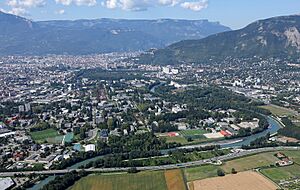
Grenoble is an important university city. In 2013, it had over 54,000 students. About 16% of these students came from other countries.
The University of Grenoble was founded in 1339. Most of the university moved to a large campus outside the city in 1965. However, some smaller campuses are still downtown.
Since 2016, the main university institutions have merged to form the Université Grenoble Alpes. This includes sciences, social sciences, and humanities. The Grenoble Institute of Technology (INPG) also joined in 2020.
Other schools in Grenoble include the École nationale de l'aviation civile (for civil aviation) and the Grenoble École de Management (a business school).
Science and Engineering Research
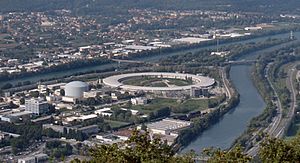
Grenoble is a major science hub. It's especially strong in physics, computer science, and applied mathematics. The Grenoble Institute of Technology trains many engineers each year. The city's high-tech focus is on information technology, biotechnologies, and new energy.
Many research labs work together with the University, the Institute of Technology, and the French National Centre for Scientific Research (CNRS). Other important research centers nearby include the European Synchrotron Radiation Facility (ESRF) and the Institut Laue-Langevin (ILL). The Commissariat à l'énergie atomique (CEA) also has a main research facility here.
Minatec is a new center for micro- and nano-technology. It helps Grenoble stay a top European science center. Biotechnologies are also strong here.
Grenoble also has big labs for space research and understanding the universe. These include the Institut de radioastronomie millimétrique and the Institut de planétologie et d'astrophysique de Grenoble.
To boost this technology area, universities and research groups created the GIANT Campus. Their goal is to be one of the world's best campuses for research, education, and high tech.
Grenoble has the second-highest number of important jobs in France, after Paris. Many of these jobs are in design and research. It is also the largest research center in France after Paris.
Economy
Industry is a big part of Grenoble's economy. High-tech industries are very important. This includes semiconductors, electronics, and biotechnology. Companies like STMicroelectronics, Schneider Electric, and Soitec have large factories and research centers here.
Traditional industries are also present. These include heavy equipment and chemistry. Companies like Caterpillar and GE Renewable Energy are examples.
Grenoble was once famous for making gloves. A few small companies still make very high-quality gloves.
Major Companies
Many large companies have offices or factories in the Grenoble area. Here are some of the biggest employers:
| Enterprise, location | Number of employees |
Sector |
|---|---|---|
| STMicroelectronics, Grenoble and Crolles | 5,979 | Making semiconductors, research |
| Schneider Electric, Grenoble area | 4,915 | Electrical equipment, research |
| Caterpillar France, Grenoble and Echirolles | 1,865 | Building heavy equipment |
| Hewlett-Packard France, Eybens | 1,814 | Computer science |
| Becton Dickinson, Pont-de-Claix | 1,736 | Research and making drug delivery systems |
| Carrefour, Grenoble area | 1,165 | Supermarkets |
| Capgemini, Grenoble | 1,100 | IT consulting and services |
| Groupe Casino, Grenoble area | 990 | Supermarkets |
| Samse, Grenoble area | 965 | Building materials supplier |
| Soitec, Bernin | 952 | Making special semiconductor wafers |
Many American and British workers live in Grenoble because of these companies. The area has the second-largest English-speaking community in France, after Paris.
The publisher Glénat has its main office in Grenoble. Inovallée is a science park near Grenoble with about 12,000 jobs.
Local Media
téléGrenoble Isère is the local TV channel. The main local newspaper is Le Dauphiné libéré.
Sports in Grenoble
Grenoble hosted the 1968 Winter Olympics. The city is surrounded by ski resorts. Stade Lesdiguières in Grenoble has hosted international rugby games.
Grenoble has professional teams for rugby union (FC Grenoble) and ice hockey (Brûleurs de loups). It also has a football team, Grenoble Foot 38.
- The Six-Days of Grenoble is a bike race held since 1971.
- The via ferrata Grenoble is a climbing route on the Bastille hill.
Many people in Grenoble love sports and outdoor activities. This is because of the beautiful natural sites around the city. Popular activities include hiking, mountain biking, skiing, rock climbing, and paragliding. The Tour de France bike race often passes through the city.
Transportation
Grenoble has a good public transport system. It includes 26 bus routes and five tram lines. A new cable car system, the Métrocâble, is planned for 2022. Grenoble is also a great city for bicycles because it is mostly flat.
The Gare de Grenoble is the main train station. You can take high-speed TGV trains to Paris (about 3 hours). Local trains connect Grenoble to Lyon, Geneva, and Valence.
You can fly to Grenoble from Grenoble-Isère Airport, Lyon-Saint Exupéry Airport, or Geneva International Airport. Buses connect these airports to the city.
Highways link Grenoble to other major cities. These include the A48 to Lyon, the A49 to Valence, and the A41 to Chambéry, the Alps, and Italy/Switzerland.
From 2014 to 2017, Grenoble tested renting 70 I-Road electric cars.
In 2016, the speed limit was lowered to 30 km/h (19 mph) on most streets. This was done to improve safety and reduce pollution.
Culture
Grenoble hosts several festivals. These include the Détours de Babel in March and the Open Air Short Film Festival in July. The Cabaret Frappé music festival is also held in July.
The Summum is the biggest concert hall in Grenoble. The main cultural center is called MC2. It hosts music, theater, and dance shows. The Conservatory of Grenoble was founded in 1935.
Grenoble has several theaters. The main one is the Grenoble Municipal Theatre. There are also art centers like Le Magasin.
Grenoble is famous for its walnuts, called Noix de Grenoble. These walnuts have a special protected origin. The city is also home to a well-known comics publisher, Glénat.
International Connections
After World War I, a street in Serbia was named "French street." In return, a street in Grenoble was named "Palanka street." There is also a "Belgrade Street" nearby.
Twin Towns and Sister Cities
Grenoble is twinned with many cities around the world:
|
|
Images for kids
See also
 In Spanish: Grenoble para niños
In Spanish: Grenoble para niños





